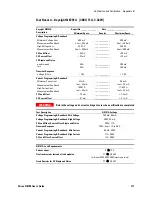
Appendix B
Verification and Calibration
102
Series N8700 User’s Guide
WARNING
SHOCK HAZARD
Before starting the verification procedures, check to make
sure that the startup mode is set to Safe-Start (see page 44).
Constant Voltage Tests
Refer to the appropriate test record in the following section for the
instrument settings for each of the following tests.
Voltage Programming and Readback Accuracy
Test category = performance, calibration
This test verifies that the voltage programming and measurement
functions are within specifications.
1
Turn off the power supply and connect a DVM directly across the
+S and -S terminals as shown in figure A. Do not connect a load.
2
Turn on the power supply and program the output voltage to zero
and the output current to its maximum programmable value
(Imax) with the load off. The CV annunciator should be on and
the output current reading should be approximately zero.
3
Record the output voltage readings on the digital voltmeter
(DVM) as well as the measurement readback. The readings
should be within the limits specified in the test record for the
model being tested under Voltage Programming and Readback,
Minimum Voltage Vout.
4
Program the output voltage to its full-scale rating.
5
Record the output voltage readings on the DVM as well as the
measurement readback. The readings should be within the limits
specified in the test record for the appropriate model under
Voltage Programming and Readback, High Voltage Vout.
CV Load Effect
Test category = performance
This test measures the change in output voltage resulting from a
change in output current from full load to no load.
1
Turn off the power supply and connect a DVM and an electronic
load as shown in figure A.
2
Turn on the power supply and program the output current to its
maximum programmable value (Imax) and the output voltage to
its full-scale value.
3
Set the electronic load for the output’s full-scale current. The CV
annunciator on the front panel must be on. If it is not, adjust the
load so that the output current drops slightly.
4
Record the output voltage reading from the DVM.
5
Open the load and record the voltage reading from the DVM
again. The difference between the DVM readings in steps 4 and 5
is the load effect, which should not exceed the value listed in the
test record for the appropriate model under CV Load Effect.
















































